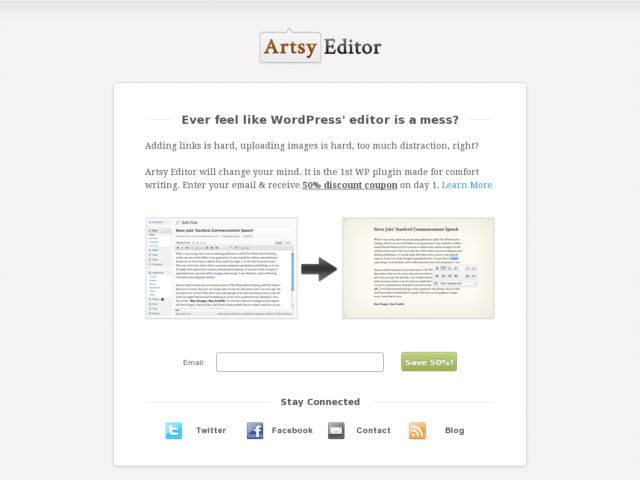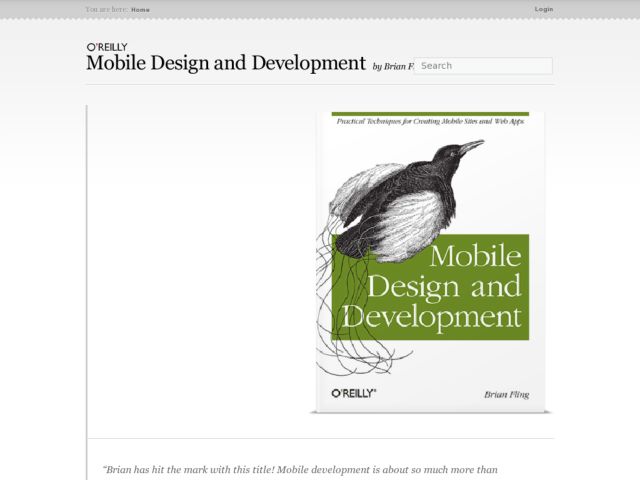I don't use WYSIWYG editors in CMSes and blogs, but I like how Stephen Ou designed this simple WP editor plugin called Artsy Editor using a little HUD style popover.
Blog
Read "Mobile Design & Development" free online
Brian Fling's book, Mobile Design & Development, published by O'Reilly in 2009, is available to read in its entirety online. Fling says he says 75-80% of the content of the book (which is some 68,000 words) is up to date and extremely relevant as of March 2011.
More from the author:
I wrote this book to have something for everyone interested in designing in developing for mobile devices, regardless of experience and regardless of the application. The first half is a crash course in the mobile ecosystem: how to develop a strategy, address the mobile context—even how to decide which of the multiple mobile application types is best for you, and finally, how to create a user experience for it. The second half is focused on using these principles to make a mobile website or web app.This means this book isn't for anyone looking for a quick fix to the “mobile problem.” As I told my excellent editorial team throughout the writing process, “this is a book that teaches people how to cook, not a collection of recipes.” However being O'Reilly's first book on mobile, we decided to cover a lot of ground, basically detailing mobile from it's origins to the devices of tomorrow.
Read at the book site.
Have a nice day
Don't let anyone tell you that the tools you choose are wrong or inappropriate. Find the right design and keep winning.
Occasionally I'm asked to provide an opinion about a topic that people think I should have some authority to comment on for some reason. That topic, as you might guess, is wireframing.
I enjoy pointing people towards good resources, or helping them with a problem using a tool that I'm familiar with. I also love to give my own design resources to peers, or to teach techniques that I think will help people perfect their craft. In the end, I benefit from that exchange the most.
When asked to comment on slanted opinions that throw a stake in the ground and tend to confuse and divide the community, I abstain. Navel gazing and defining the damned thing became an uninteresting use of time to me long ago. It took some time immersed in those conversations to know that I have nothing to contribute. I'd rather be making stuff than talking about it. I just say call yourself whatever you like, and do whatever works.
Interface design tools are as good as you make them. When I started out, I had to use Visio to communicate UI specs. It wasn't awesome, but I made it work. Later I found Omnigraffle. It was not designed specifically to enable interface designers, but we made it awesome. We learned how to use it to make our documents communicate design ideas.
We are the ones who determine what's useful for us after immersion in tools. We've debated what we want in the ultimate IA tool, we've found parallels in other industries and fields of practice and made them our own. We've experimented with forward-looking low-fidelity prototyping projects like Denim, and pondered what the right suite of tools are for our work. Some of us built them and shared our work. Some of us are still building them.
Over years of working and watching others work, I've noticed that some attributes are common among the people whose work I admire. The people who are the most effective seem to continue to study their practice, and perfect their craft. After long hours of use, they find the way to flow within any app at their disposal, and become as fast and effective as they can using it. The key is what they do with the app once they've become expert at their craft, expert in finding the right design, expert in communicating, and expert in refining. There's some kind of maker/doer tenacity I see in people, and it doesn't have to do with any one tool.
There are no good or bad tools for finding the right design. Paper prototypes are your thing? Awesome. If you want to sketch and go right to building in HTML? Go for it! I've done it. You want to craft gray box schematics in OmniGraffle, Photoshop, or Mockups? Godspeed you wireframer. Maybe I can help you with that. You want to use a tool that generates interactive prototypes? Have a nice day. :)
All the side-taking is useless to me. If you've ever interviewed people for an IA or IXD position, you know that beautiful documents and prototypes are meaningless if in the end they don't demonstrate good problem solving and good design decision making. I don't care what people use. They can use finger puppets and crayons if they help them.
I say use whatever makes sense or is at your disposal. Your tools are only as effective as you are at using them to accomplish goals. But don't let anyone tell you that what you choose is wrong or inappropriate. Find the right design and keep winning.

